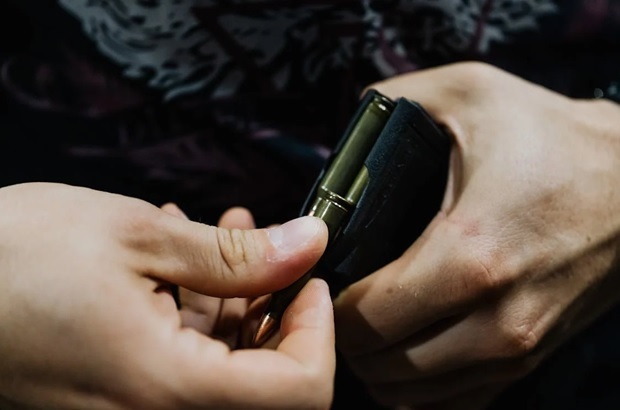Admittedly, most people that enjoy the shooting sports are neither scientists nor ballistic engineers. So it goes without saying that there’s a lot of knowledge and information that underpin these disciplines that most of us just don’t have.
With that said it’s, 2024, information abounds, and we all have access to the internet. So there’s no reason that myths like these should still plague us. Whether it has to do with long-distance shooting or has implications for your .223 bulk ammo purchase, it’s good to be informed.
Let’s fire away at these ammo myths. Pun intended.
1. Steel cased ammo will “ruin” your gun.
There’s this belief out there that steel-cased ammo, or even aluminum-cased ammo, will “ruin” your gun. Presumably, some shooters think that steel-cased ammo will scratch the chamber.
This is, in theory, a very valid concern, as steel can be heat-treated to be much harder than brass, and a scratched up chamber will hinder extraction and thereby cycling.
But there’s just no merit to these myths. Consider an option like TulAmmo’s 9mm rounds, which are cased in steel* as an example.
*They are cased in annealed steel. Annealing is a heat-treatment process whereby the steel is allowed to cool off very slowly, making it extremely soft. It is not uncommon for annealed steel to have a Rockwell Hardness rating in the low 40s, which is oftentimes softer than brass.
So, to put this to rest, neither steel-cased nor aluminum-cased ammo is inherently bad for your gun (you can’t reload those casings, though).
2. It doesn’t matter how or where you store ammo.
This is a bad one. A really bad one. It most certainly does matter how and where you store your ammo, and so do the conditions in storage.
Not only heat but humidity can wreck your ammo, and the worst part is you won’t just get failures to fire. Degradation of the primer and propellant can result in hang-fires and disrupt ballistic consistency just as likely as they can cause a misfire. This means you can ruin ammo even if it still fires.
Humidity can also damage a bullet or casing (or both) through the influence of corrosion. Before you drop a whole lot of money on a .223 bulk ammo deal, make sure you have a cool, dry, dark place to store it.

3. A bigger caliber is “better” for stopping power
Most certainly not. Although these things are often related, this is not universally the case. The bullet itself is just as important as caliber is.
Take a 9mm hollow point and contrast this with a .45 ACP full metal jacket bullet. The hollow point is less likely to overpenetrate and will drop its energy in the target more efficiently.
Also, the number of shots fired matters here. Three rounds of a smaller caliber (like 9mm) will invariably do more damage to a target than one shot from a .45 ACP. So shot placement and the number of shots fired matter just as much as caliber.
That is to say, your ability to control and fire the handgun accurately is just as important as, if not more important than, caliber.
4. Lighter bullets always shoot flatter
Take a .22LR bullet that weighs 38 grains and compare it to a .223 bullet that weighs 55 grains. The .22LR will drop almost 3 feet at 200 yards and the .223 will drop somewhere shy of 14 inches.
That’s a significant disparity, and it holds true across lots of calibers. Now, oftentimes a heavier bullet drops faster, but not always. We have also to consider the powder charge, muzzle velocity, and most importantly, BC, or ballistic coefficient.
5. Bigger cartridges/bullets are better for long-range shooting
You might think that the hotter the powder charge, the better a cartridge would be for long-range shooting, and this is sometimes - but not always - the case.
Take .223 again, which has a case capacity of just about 28 grains. Now consider something much larger, like .50 Beowulf, which has a case capacity of just about 65 grains.
The hotter load of the .50 Beowulf would then make it better for long-range shooting - however, if you’re at all familiar with this cartridge you will confidently know that this is not the case.
Again, it comes down (mostly) to ballistic coefficient, which in turn influences bullet drop, especially at extended ranges.
6. The .223 Remington and 5.56 NATO are the same cartridge

This is another really bad myth, and one you’ll want to know about before you buy a whole load of .223 bulk ammo.
At first glance, these cartridges do appear the same. After all, their dimensions are effectively identical.
The thing is this: the 5.56x45 NATO is loaded to cartridge pressures slightly higher than the .223 Remington, which can result in damage to the rifle, if not outright, catastrophic failure, if a 5.56 cartridge is fired from a firearm chambered for .223 Remington ammo.
So keep that in mind. Do not mix these two cartridges up and feed your rifle only the cartridge indicated on the barrel stamp.
Be Free of These Ammo Myths and Stock Up Here
Need more .223 bulk ammo? Or bulk 5.56 NATO ammo? Or 9mm? Or even target 12 gauge shells? Get them here, now that you know better about how to store them and what the nuanced differences are between some cartridges.
And, while you’re here, don’t miss a chance to check out our police trade-in specials and other hot deals.

